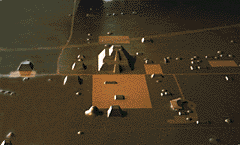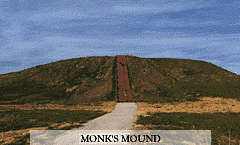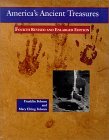
Editorial
|
Fragments
|
Cahokia I
|
Piasa Creature I
|
Sphinx II
Questions? Comments? Suggestions?
Contact us!
Register
for our Hall of Records Newsletter!
Questions? Comments? Suggestions? Advertising? Press Releases?
Contact us!
Cahokia: Forgotten Jewel of the Midwest Part II
 ahokia, as it is now called, is the largest known mound complex in North America, and contains the
largest earthen mound in the world: "Monk's Mound". This massive mound, named for the monastery that
once graced its summit, sat at the center of the largest known city complex in North America,
which is believed to have supported over 20,000 people at its peak. Cahokia in turn sat at the center
of a massive network of village and lesser mound complexes, stretching from what is now Wisconsin
(Aztalan)
throughout the midwestern and southeastern United States. In fact, Cahokia rivaled in size and scope
even the huge pyramidal complexes of South and Central America, and should rightfully be considered
the North American equivalent of the great cities of those continents.
ahokia, as it is now called, is the largest known mound complex in North America, and contains the
largest earthen mound in the world: "Monk's Mound". This massive mound, named for the monastery that
once graced its summit, sat at the center of the largest known city complex in North America,
which is believed to have supported over 20,000 people at its peak. Cahokia in turn sat at the center
of a massive network of village and lesser mound complexes, stretching from what is now Wisconsin
(Aztalan)
throughout the midwestern and southeastern United States. In fact, Cahokia rivaled in size and scope
even the huge pyramidal complexes of South and Central America, and should rightfully be considered
the North American equivalent of the great cities of those continents.

Around 1000 b.c., the "Woodland Culture" began to develop in eastern North America. This culture
appeared in the "American Bottom," a low point of land surrounding the confluence of the Mississippi
and Missouri Rivers, around 600 b.c. Over the next 1,400
years, this Woodland Culture began to become more and more settled in the Midwest, and began to develop
complex religious, social, economic, and political systems. In effect, these Native Americans had
"settled" in the American Bottom and, for a time at least, these previously nomadic people had become
civilized.

Starting around 500 b.c., various subgroups of Native Americans, including the Adena and the Hopewell,
began to build earthen burial mounds and effigy mounds in the shape of animals. From this point,
mound building would become a central part of life for the Native Americans of the American Bottom.
The Mississippian Culture, which built the Cahokian acropolis, evolved in three stages: the Late
Woodland Era (a.d. 600-800), the Emergent Mississippian Era (a.d. 800-1000), and the Mississippian Era
(a.d 1000-1400).
Cahokia reached its apex between 900 and 1200 a.d., during Europe's dark ages, and lasted until 1400 a.d.,
when the site was abandoned for unknown reasons.
Cahokia Timeline, 700 b.c. to 1800 a.d.
|
Century
|
Cultural Traditions
|
Cahokia Phases
|
Activities in Cahokia Area
|
Elsewhere in the World
|
|
1800
|
Historic
|
Colonial
|
Trappist Monks
French chapel on Monk's Mound
Cahokia Illini arrive
|
French Revolution
American Revolution
Horse introduced to Plains
|
|
1700
|
|
1600
|
|
1500
|
Oneota
|
Vulcan
|
Oneota villages nearby
|
Spanish Armada sails
Columbus arrives
Aztec civilization
|
|
1400
|
|
1300
|
Mississippian
|
Sand Prairie
Moorehead
Stirling
Lohman
|
Site abandoned
Climate change
Decline begins
Peak occupation
Stockades built
Woodhenges built
|
Aztec civilization
Marco Polo in Asia
Crusades
Toltec Civilization
Vikings in America
Mesa Verde thriving
|
|
1200
|
|
1100
|
|
1000
|
|
900
|
Emergent Mississippian
|
Edelhardt
Merrell
Loyd
|
Mound 72 Burials
First Mounds built
Occupation expands
|
Charlemagne reigns
Collapse of Mayans
|
|
800
|
|
700
|
Late Woodland
|
Patrick
|
First settlements at site
Villages nearby and on bluffs
|
Effigy mounds in Iowa
Mayan peak
Mohammed born
Black Plague
Fall of Rome
Dark Ages begins
|
|
600
|
|
500
|
|
400
|
|
300
|
|
200
|
Middle Woodland
|
--
|
Villages nearby in bottoms
|
Hopewell Mounds in Ohio
Chinese invent paper
Serpent Mound, Ohio
|
|
100
|
|
A.D.
|
|
- 0 -
|
|
Birth of Christ
|
|
B.C.
|
Early Woodland
|
--
|
Scattered hamlets in area
|
London founded
Hannibal over Alps
China unified
Punic Wars
Olmec civilization
Sparta flourished
Buddha born
Persian Empire
|
|
100
|
|
200
|
|
300
|
|
400
|
|
500
|
|
600
|
|
700
|
Late Archaic
|
--
|
Hunting camps
|
Rome founded
|
|
Table from
Cahokia: City of the Sun
(Collinsville, IL: Cahokia Mounds Museum Society, 1992), 14.
|

The Cahokia site contains over 100 mounds of various sizes, dating throughout the mound-building
period, some of which contain extensive burial artifacts. It also contains a "woodhenge", a circle
of upright logs used by the Cahokian priesthood as a sort of celestial calendar, just as the triptychs
of stonehenge were used by the Celts of ancient Britain to determine the start of their year, predict
eclipses, and regulate their daily lives. It is also known that the Cahokians built a defensive wall
around the mound complex, part of which has been reconstructed. It is similar in style to that built
by the inhabitants of
Aztalan
, as covered in the Winter 1998 issue of Mysterious World, built in the same fashion, and even
using "stockades" at regular intervals along the walls. These close similarities, combined with the
known links between Aztalan and Cahokia, give more credence to the idea put forth in our Aztalan article
that the ancient Aztecs had migrated to Mexico from the north, possibly from as far north as Aztalan.
Cahokia is also a contender for an origin point for the Aztecs, but in either case, the extensive
mound-building culture in North America and the similarity in building styles between North and
Central American pyramidal structures makes it clear that there was some sort of cultural contact at
some point.



|

|
Monk's Mound
|
Restored Stockade Wall Section
|
Murdock Mound
|
Southwest Palisade
Southeast Palisade Platform
|
Southeast Palisade Mound
|
Cahokia Mounds Interpretive Center
Who knows the contacts the ancient Cahokians had with their southern neighbors, the Aztecs, or even their
local neighbors in what is now known as North America? The Cahokians left no written records, and they
have long since abandoned the site, either blending in with the surrounding peoples, or perhaps migrating
south to help form the Aztec Empire, as some have suggested. In either case, this massive complex,
sitting at the center of an ancient mound culture that spread throughout the midwestern and
southeastern United States, is truly the forgotten jewel of the Midwest.
Visit us again this summer, where we will further investigate the Cahokian people,
their religious, social, economic and political institutions, and the material culture that they
left behind. 

Cahokia Mounds State Historic Site, administered by the Illinois Historic Preservation Agency, is
just eight miles from downtown St. Louis near Collinsville, Illinois, off Interstates 55-70 and 255, and
Illinois 111, on Collinsville road. It is open daily free of charge, although a donation of $2 for adults and
$1 for children is suggested. Call (618) 346-5160 for more information or a 1999 Calendar of Events.

 Official Cahokia Mounds Site
Official Cahokia Mounds Site
 Illinois Historic Preservation Agency: Cahokia Mounds
Illinois Historic Preservation Agency: Cahokia Mounds
 Cahokia page hosted by School District 54 in Schaumburg, Illinois
Cahokia page hosted by School District 54 in Schaumburg, Illinois
 A Select Bibliography of Published Cahokia Archaeology
A Select Bibliography of Published Cahokia Archaeology
Cahokia: Forgotten Jewel of the Midwest Part II
Editorial
|
Fragments
|
Cahokia I
|
Piasa Creature I
|
Sphinx II
Questions? Comments? Suggestions?
Contact us!
Register
for our Hall of Records Newsletter!
Questions? Comments? Suggestions? Advertising? Press Releases?
Contact us!



 Cahokia: City of the Sun:
Cahokia: City of the Sun:
Prehistoric Urban Center In The American Bottom
Claudia G. Mink
Rating:





Cahokia Mounds State Historic Site preserves the remains of the most
sophisticated prehistoric Indian civilization north of Mexico, circa A.D.
900-1300. Designated a UNESCO World Heritage Site in 1982,
Cahokia is noted for its important role in the prehistory of North
America. This book, written for a general audience, introduces the reader
to this ancient metropolis, with its towering 100 foot-high Monks Mound
and American Woodhenge sun calendar. This is the astounding story of
an advanced Indian culture in North America that thrived and then
declined before European contact. Compact and readable, this book is personally
recommended by the publisher as the perfect starter book for those interested
in further study of Cahokia.
Click
here
to buy this book.
 The Cahokia Atlas:
The Cahokia Atlas:
A Historical Atlas of Cahokia Archaeology
(Studies in Archaeology)
Melvin L. Fowler
Rating:





This book is an excellent and very well written introduction to Cahokian history, archaeology,
topography, and everything the casual and advanced reader might want in a book about Cahokia.
Very readable and well illustrated, this book is personally recommended by the publisher.
Click
here
to buy this book.
 Cahokia and the Archaeology of Power
Cahokia and the Archaeology of Power
Thomas E. Emerson
Rating:




"Much of the work in the rich flood plain known as the American Bottom has
focused on the huge Mississippian center of Cahokia and other large mound
sites. Emerson opts to evaluate the radiation of chiefly power into the rural
communities, and how these were transformed as the power of elites at
Cahokia waxed and waned. His work is further distinguished by its focus on
ceremony and ritual as cornerstones of elite power....Another major strength
of the volume is its approach to settlement analysis....North American
archaeologists are caught up in a period of exciting (and mostly civil) debates
about the political economy of Mississippian societies. Cahokia and the
American Bottom in particular have become an important testing ground for
evaluating competing ideas about the nature of chiefly power. Emerson's work
reflects the growing sophistication of the approaches being brought to bear on
this issue and is to be commended for its thoughtful articulation of method and
theory."
Click
here
to buy this book.
 Cahokia: Domination And Ideology In the Mississippian World
Cahokia: Domination And Ideology In the Mississippian World
Timothy R. Pauketat (Editor), Thomas E. Emerson (Editor)
Rating:




About one thousand years ago, Native Americans built hundreds of earthen platform mounds, plazas,
residential areas, and other types of monuments in the vicinity of present-day St. Louis. This
sprawling complex, known to archaeologists as Cahokia, was the dominant cultural, ceremonial, and
trade center north of Mexico for centuries. This stimulating collections of essays casts new light
on the remarkable accomplishment of Cahokia. The nine contributors explore a wide range of topics -
religion, trade, the nature of local and regional ideologies, social organization, subsistence,
mound construction, and the longstanding question of Cahokia's relationship to later Mississippian
chiefdoms across the Southeast. Cahokia emerges from this book as a significant focal point of
eastern native history. It was prominently situated at the center of a vast regional network that
was simultaneously ideological, religious, and economic - an intricate system of thought, ritual
and power whose effects were felt for centuries.
Click
here
to buy this book.
 Cahokia and the Hinterlands:
Cahokia and the Hinterlands:
Middle Mississippian Cultures of the Midwest
Thomas E. Emerson (Editor), R. Barry Lewis (Editor)
Rating:




This fascinating look at one of the most important archaeological sites in North America brings
together the latest research by active Mississippian scholars within the Upper and Central
Mississippian Valley. It details the rise of a complex prehistoric society that influenced
cultures throughout the Midwest. This volume is illustrated with maps, drawings of artifacts,
charts, tables, and photographs. Its contributors cover topics as wide-ranging as cultural
history, the development of social ranking, regional cultural variation, cultural taxonomy,
economic modeling, craft specialization, settlement patterns, models of frontier development,
and agricultural and subsistence systems. Their work will contribute much to the understanding
of the rise of chiefdoms and stratified societies and the development of trade throughout the world.
Click
here
to buy this book.
 The Ancient Splendor Of Prehistoric Cahokia
The Ancient Splendor Of Prehistoric Cahokia
Sidney G. Denny, Ernest L. Schusky, John Adkins Richardson (Illustrator), John D. Richardson
Most books on Native American culture concentrate on the periods
just before, during, and after contact with European civilization. This one,
however, offers a glimpse of American life in a much earlier period. The
authors believe that the Cahokia Mounds site in southern Illinois "represents
the most complex social and political culture of prehistoric North American
Indians." The book describes the archaeological finds and the layout of
Cahokia, relates it to other sites in the U. S. and Mexico, and discusses the
deductions made about the people who lived at Cahokia and the mysteries
that remain. The black-and-white illustrations, mainly drawings with a few
fuzzy photographs, vary in style and in quality of reproduction. Although the
pictures add interest to the text, the practice of captioning them only in the
appended list of illustrations limits their usefulness, especially for children.
Despite these drawbacks, the book provides a basic introduction to Cahokia
Mounds. That alone will make it a useful addition to libraries, particularly in
the Midwest.
Click
here
to buy this book.
 Lost Cities and Ancient Mysteries of North and Central America
Lost Cities and Ancient Mysteries of North and Central America
David Hatcher Childress
Rating:




One of the popular "Lost Cities" series, this book is a must-have guidebook for mysterious places
in North and Central America. I enjoy Childress' books mainly because he comes across as very honest,
although he engages in too much speculation to be taken at face value. Overall I find his books a
very engaging read, and the speculative aspect, though often unscientific, is very entertaining.
Moreover, the amazing amount of study and travel he has done brings a certain amount of
credibility to his work. I highly recommend the "Lost Cities" series of books both for their
refreshingly informal approach and for their "infotainment" value. These books are
definitely not for the timid, and certainly not for the closed-minded.
Click
here
to buy this book.
 America's Ancient Treasures: A Guide to Archaeological Sites
America's Ancient Treasures: A Guide to Archaeological Sites
and Museums in the United States and Canada
Franklin Folsom
Rating:    
America's ancient treasures (1993 edition) is a reprint of a classic first printed back in 1971. It contains a thorough recounting of every major and most minor Native American archaeological sites and museums in North America, and is an excellent resource tool for those interested in a serious exploration into North America's ancient past. (Review by Mysterious World)
Click
here
to buy this book.


 Serpent Mound
Serpent Mound
Rusty Crutcher
Rating:




Crutcher's "Serpent Mound" is an excellent blend of piano and keyboards, Lakota flute, ocarina, and
exotic percussion, plus subtly blended environmental recordings. I highly recommend this CD as one
of the best of its genre I have heard. (The background music on this page is from "Osa", the first
track of this CD.)
Click
here
to buy this CD.


Mound Builders
Rating:




From the popular "In Search of History" series, "Mound Builders" gives us a good overall understanding
of the mound building cultures that dominated North America over a thousand years ago. All aspects of
North American mound building are covered.
Click
here
to buy this video.
|
